Restoring a culture: One Indigenous leader’s fight for her people | Indigenous Rights
Table Bluff Reservation, United States – “You’d get beaten. It would only cause you pain.” Those were the lessons that Cheryl Seidner grew up hearing from her grandfather, a man who had learned the hard way what it meant to be Wiyot in the United States.
The Wiyot tribe has lived in the Humboldt Bay region of northern California for thousands of years, since time immemorial. But Seidner’s grandfather had discovered that, if — for example — he spoke the Wiyot language Soulatluk in school, it would earn him a bang on the head or a slap with a ruler.
He did not want his children to endure the same abuse growing up. He did not want it for his grandchildren, either.
“So that’s why he wouldn’t teach his children how to speak Soulatluk,” Seidner explains. “He wouldn’t teach them. Because it would only cause problems, only cause heartache.”
Seidner’s grandfather was part of the last generation to speak fluent Soulatluk. He died in 1960, when Seidner was only 10. But decades later, Seidner would take on a role her grandfather might never have imagined: she became a leader in helping to restore Indigenous lands and culture.
‘You continue on’
Quick to smile, with a mane of black curls streaked in grey, Seidner made international news in 2019 when the city of Eureka voluntarily returned more than 202 acres (82 hectares) of sacred land to the Wiyot people, becoming the first municipality in the US known to do so.
The transfer was the result of decades of advocacy. But for 72-year-old Seidner, the dream goes back farther: to a childhood spent along the misty California coastline, where the land drops steep into the sea.
Even today, from the deck of her mint-green house on the Table Bluff Reservation, Seidner can still see the tree ridge where she grew up, rising along the horizon where the silver of the Pacific licks the churning grey sky.
Consumed by a fire several years ago, her family’s house used to stand there. “You talk about the good old days? They were the good old days,” Seidner says with a laugh.
The youngest of five children, Seidner remembers trailing after her mother Loreta, gathering wild berries and hazelnuts among the shrubs. Quail would whoop and caw. And Seidner would spirit her bounty of hazelnuts back home, where she would stick them behind the wood stove to dry: otherwise, the husks could splinter like fibreglass, rather than yield the fruit inside.
Some days she would wake up to her mother baking salmon nape for breakfast, served with eggs and potatoes. Or her father William would be returning from an early morning fishing trip, preparing his catch for either the pan or the smokehouse.
At home, she felt safe. Winter storms would make the house creak and buckle. Torrential rain would swell the nearby rivers, sometimes washing away entire towns. But Seidner never fretted.
“I had mom and dad. What was I to be afraid of? That’s how I looked at it growing up,” Seidner says. “I didn’t have to be afraid of anything.”
But a shadow lingered in her community’s past — a tragedy, an injustice, whose effects continue to be felt to this day. Seidner’s parents did not talk about it much. Their perspective was that it was better to move on.
“You get up and you continue on. I learned that from my dad,” Seidner said. “And what you do today is that you don’t let people do that again.”

A massacre on Wiyot land
In February 1860, the Wiyot people had gathered on what traditionally marks the spiritual heart of their world: Tuluwat, a low-lying island nestled in the channels of Humboldt Bay. They were there to hold their annual world renewal ceremony, a celebration that could last up to 10 days.
The ceremony was meant to restore balance to the world, through dance, prayer and ritual. But recent years had not been kind.
In the 1840s and 50s, the discovery of gold in California led to an influx of predominantly white settlers. Humboldt Bay became a popular port of call for would-be miners. The city of Eureka was founded upon its shores. And the newcomers were increasingly targeting the area’s Indigenous peoples as impediments to their ambitions.
“It is no doubt true that the whites are becoming impressed with the belief that it will be absolutely necessary to exterminate the savages before they can labor much longer in the mines with security,” the publication Alta California wrote on April 26, 1849.
Laws like the 1850’s Act for the Government and Protection of Indians soon allowed for the removal of Indigenous residents from the land and gave white settlers the right to use them as forced labour — even the children. A new US army installation, Fort Humboldt, was erected to protect nascent settlements.
But settlers grew frustrated that the troops were not doing enough to address perceived threats, and groups of vigilantes started to form, carrying out attacks of their own. One of the most infamous would happen on February 26, 1860, in the midst of the Wiyots’ world renewal ceremony.
Newspaper headlines over the following days would register the horror. “Indiscriminate massacre of Indians,” one read. “Women and children butchered.” In the early hours of morning, the vigilantes had snuck onto Tuluwat Island. The Wiyot men were away on the mainland collecting supplies: it was mostly the elders, women and children who remained on the island to rest.
“Neither age nor sex had been spared,” reporter Bret Harte wrote. He detailed crushed skulls and hatchet wounds, meted out indiscriminately, even to “infants scarce a span long”. Harte’s report spread quickly — so much so that he started to receive threats to his life. He fled to San Francisco.
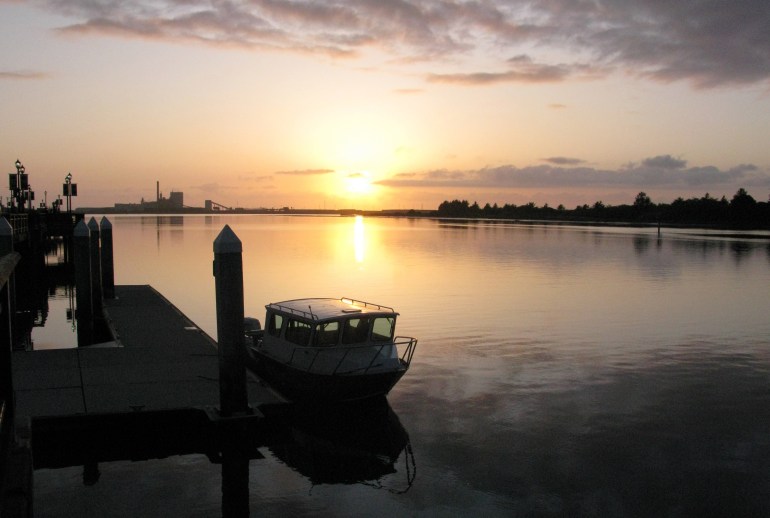
Asking questions about the past
The death toll was estimated between 80 and 250. None of the vigilantes was ever brought to trial. But the Wiyot were removed from Tuluwat Island, relocated to Fort Humboldt and reservations farther away. Traditions like the annual world renewal ceremony stopped. And by 1910, the Wiyot population dipped to approximately 100.
“Our culture kind of got buried along with all those people who died on the island,” Seidner says. Her great-grandfather, Jerry James, was among the few survivors that night. Only an infant, he was reportedly found in his dead mother’s arms.
But Seidner’s parents encouraged her to look forward, not back. “We live in today. And what’s in the past stays in the past,” her mother told her.
Meanwhile, her grandfather, who had experienced his own trauma, was more direct: “You learn the way of the white man. They’re here to stay. They’re not going back where they came from. So you have got to learn how to get along.”
Still, Seidner remained curious — about the language that was not spoken, the ceremonies that were no longer practised. She gleaned what she could from conversations with her grandmother and mother.
“We didn’t start out talking about culture, but we ended up talking about it,” Seidner says. “That’s when I’d start asking questions.”
All the inquiries could sometimes frazzle her ageing grandmother. “The only time people come around me is when they want information,” Seidner remembers her harrumphing. But what Seidner learned would ultimately lead to a cultural rejuvenation, nearly 150 years after the massacre that tried to extinguish the Wiyot ceremony for good.

A ceremony’s return
In the mid-2000s, Michelle Hernandez Wenzler was asking questions of her own. She was approaching her 15th birthday, an age freighted with expectation and promise.
Her family was part Wiyot, part Mexican, so her parents wondered: did she want a traditional Mexican quinceañera celebration to mark the occasion? Or what about a sweet 16 party the following year, to celebrate the way many American teens do?
Hernandez Wenzler pondered the question. “Well, I don’t want to [be] a quinceañera, because I don’t want that big flowery dress,” she thought. And she was not sold on the idea of a sweet 16, either. So she returned the question to her parents. What do we do as Wiyot people to celebrate a coming-of-age?
Hernandez Wenzler had moved to the Table Bluff Reservation just a few years earlier, when she was about 11. Growing up, she had always been afraid of visiting. The sharp cliffs on Highway 101 gave her nightmares about tumbling into the sea.
But as Hernandez Wenzler settled into her new life, she discovered a tight-knit community. “It was like family that we didn’t know we had,” she says. It felt like coming home.
Her first night in her new house, she remembers running from room to room, admiring the way the sounds echoed in the empty space. And soon, a friendly face arrived at the door to welcome the new family: Seidner, with a basket full of gifts.
It would be Seidner who taught Hernandez Wenzler how to drive, using her big red Tacoma truck. And it was with Seidner and her sister Leona Wilkinson that Hernandez Wenzler learned traditional basket-making. She still remembers sitting in Seidner’s backyard — an oasis of flowers and fruit, with tall grass and swaying lavender — to prepare sticks for weaving.
So when it came time to plan a traditional Wiyot coming-of-age ceremony, Hernandez Wenzler likewise turned to Seidner for help. “She asked if there was a reason why we couldn’t have one,” Seidner recalls. “And it was just: Nobody’s ever asked.”
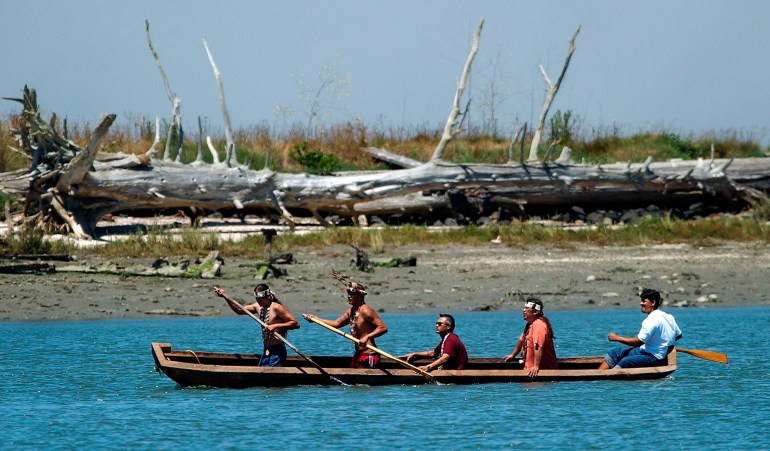
‘Evolution to everything’
But the dilemma was figuring out exactly what to do. Such ceremonies had not happened since the massacre, nearly 150 years ago. So Seidner and Hernandez Wenzler’s father, Wiyot tribal chair Ted Hernandez, dove into the research, combing through written histories for clues.
“I just started reading. I found a paragraph here, a couple [of] sentences there,” Seidner explains.
They also consulted with neighbouring tribes, including friends in the Karuk community, who held flower dances for young women entering adulthood. Seidner even travelled to the Cultural Resources Center at the National Museum of the American Indian in Maryland to pattern regalia based on a Wiyot dress held there.
“We didn’t know the answers,” Seidner says. But, she adds, not every ceremony was identical in the past, either. “We looked at it as saying there’s an evolution to everything.”
Simply constructing the dress was a community-wide affair. The right materials had to be gathered: dozens and dozens of pine nuts from the forest, clam shells and periwinkle spirals from the sea. Each individual shell and seed had to be cleaned and threaded together, so that when the deerskin skirt moved, the dress would “sing”.
“The way we see our regalia is that it’s a living being,” Hernandez Wenzler explains. “And when you hear a dress, we call it singing.”
Seidner and her sister Wilkinson even broke into their personal stores of materials to sew a thick veil of bluejay feathers for Hernandez Wenzler.
“You had to make it thick,” Seidner explains. According to traditional belief, the ceremony was so powerful, so transformational, that it could make onlookers sick if they caught a glimpse of Hernandez Wenzler before it was complete. “That’s why her eyes were averted or covered. That’s why we made everyone stand away and look in the opposite direction.”
The ceremony began with Hernandez Wenzler wading out into Humboldt Bay, cleansing herself in its brisk, cold waters. For three days, she fasted on acorn water, in the seclusion of a women’s-only camp. With all its shells and necklaces, her dress felt impossibly heavy. Dense fog melted into light rain. The ceremony continued.
“At 16, I was like: I cannot do this,” Hernandez Wenzler remembers. But she rallied. She danced. And now, at age 32, she looks back on that time whenever her life gets tough. “I tell myself all the time: ‘If I can do that in the cold, wearing a lot of regalia, then I can totally do anything else in life.’”
After the ceremony, her grandfather gave her a gift: a video camera. Hernandez Wenzler grew up to be a filmmaker.
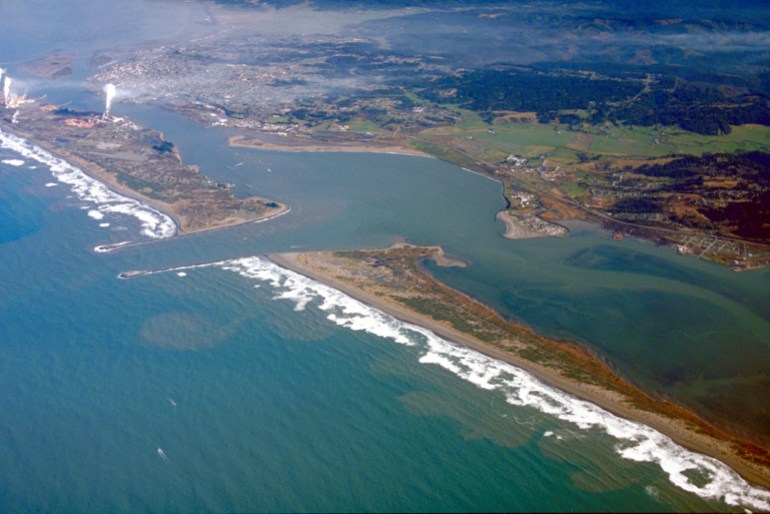
A city on fire
For Seidner, coming of age was a very different process. Born in 1950, she was a young adult in the 1960s and early 70s. And when it came time to go to college, she decided to move south briefly to San Francisco, a cradle for the counterculture.
When she arrived, she remembers thinking the whole city was on fire. Young men were burning the draft cards that summoned them to the Vietnam War. Students were on strike at San Francisco State University. And flames rose from Alcatraz Island, where a fire broke out during an occupation movement led by Indigenous activists.
The phrase she heard most back then was, “I’m trying to find myself.” But Seidner never had that kind of concern. She was confident in who she was and where she fit in the world.
“Mama always told me, ‘You are Bill and Loreta Seidner’s daughter. That’s all you need to know,’” Seidner says. “I never understood why people needed to know where they came from, because I already knew it.”
Seidner had grown up on her ancestral lands. Many other Indigenous people had not. A 2021 study published in the journal Science describes a “near total” loss of land for Indigenous peoples in the contiguous US, driven by genocide and forced migration.
Indigenous people were dispossessed of an estimated 98.9 percent of their historical lands. Of the 380 tribes assessed in the study, 160 were left with no land base at all.
Those that retained territory were often still displaced — forced to move, on average, 239 kilometres (149 miles) from their homelands, to parcels a fraction of the size and vulnerable to dangers like climate change. The Modoc people alone travelled 2,565km (1,594 miles), expelled from their home in northern California and resettled in Oklahoma.
With a loss of land came disruption to identity and tradition, as Seidner knew all too well. She dreamed of reclaiming Tuluwat Island — the centre of the Wiyot world — even when she was young.
“To tell you the truth, it was something that I had always thought about even as a teenager: that we would own the island again. But I never gave it credence,” she says.
In 1860, shortly after the Wiyot massacre, the island had been sold to a dairy farmer. He then leased the northeast corner of the island — where the Tuluwat village once stood — to a company that constructed a dry dock and shipyard there.
Dikes were cut to drain the marshes. A hazardous waste shed was built. And chemicals seeped into the groundwater. Eventually, according to the US Environmental Protection Agency, Tuluwat became what is known as a brownfield: a site contaminated by pollutants or hazardous substances.

Reclaiming land, piece by piece
But Seidner was not the only one dreaming of restoring Tuluwat to its original people. Her uncle, Albert James, started to petition authorities for the return of the island back in the 1970s.
Seidner laughs cheekily. She likes to think that she inspired her uncle to start “thinking about Indian things”. She remembers sitting at her uncle’s house to fill out her financial aid forms for college, when someone advised her to list her ethnicity as “Caucasian”, Seidner snapped.
“I said, ‘Are you saying that if I don’t put down white on here, I won’t get the loan?’ I never saw a gentleman back-pedal so fast,” she says.
Seidner professes that she has always been outspoken — quick to speak up whenever something unsettled her. It even happened in elementary school. Her fourth grade teacher introduced a lesson on Christopher Columbus by asking, “Who discovered America?”
“All these little arms go up in the air. ‘Christopher Columbus! Christopher Columbus!’” Seidner recalls. “And my little brown arm came up, and I said, ‘The Wiyot people have always been here. Nobody found us.’”
Even as an adult, she bristled at the hoopla surrounding Columbus. The year 1992 marked the 500th anniversary of Columbus’s arrival in the Americas, and the US government sponsored a tour of the replicas of Columbus’s three ships. The California coastline was among the ships’ stops.
Seidner had no interest in celebrating Columbus. But the tour spurred her to think about what she would prefer to commemorate instead. Together with her sister, a pastor and the president of the local historical society, Seidner came up with the idea of holding a candlelight vigil to honour those who died in the 1860 massacre.
She estimates 30 to 50 people showed up at the event. “I was pretty stunned,” Seidner says. “I had no clue that many people would come out.”
The public support spurred Seidner to another idea: to raise funds to buy back Tuluwat Island, piece by piece. It was a grassroots effort. She and other community leaders held bake sales, sold T-shirts and asked for donations in order to collect the money.
But her efforts were gaining steam. One donor offered to match whatever she raised up to $40,000. And when Seidner spoke about the project at a convention for the National Congress of American Indians, a colleague stood up and slammed a $100 bill onto the table.
“I’m laying down this challenge for you to step up and help the Wiyot tribe,” Seidner remembers her telling the crowd. Her words sparked an outpouring of support.
“We had numerous $1 bills. We had coins, pennies, nickels and dimes. And the next day, the tribes came up with made-out cheques. You know those big cheques they give out? From $2,000 to $5,000 each. And when we added it all up, we had $40,000, and that’s what we needed,” Seidner says. “I was taken aback. I did not know we could do that.”
By the year 2000, the Wiyot people had raised the $106,000 total needed to buy 1.5 acres (0.6 hectares) on the northern edge of the island. The city of Eureka donated the surrounding land four years later. It was only a small fraction of the island, but it was a start.
“We got the money we needed in less than 12 months. That’s what astonished me,” Seidner says. “But what stops you? Your own inhibitions?”
With part of Tuluwat back in Wiyot possession, the clean-up of their sacred land could begin. And the ceremony that started in 1860 could finally be complete.
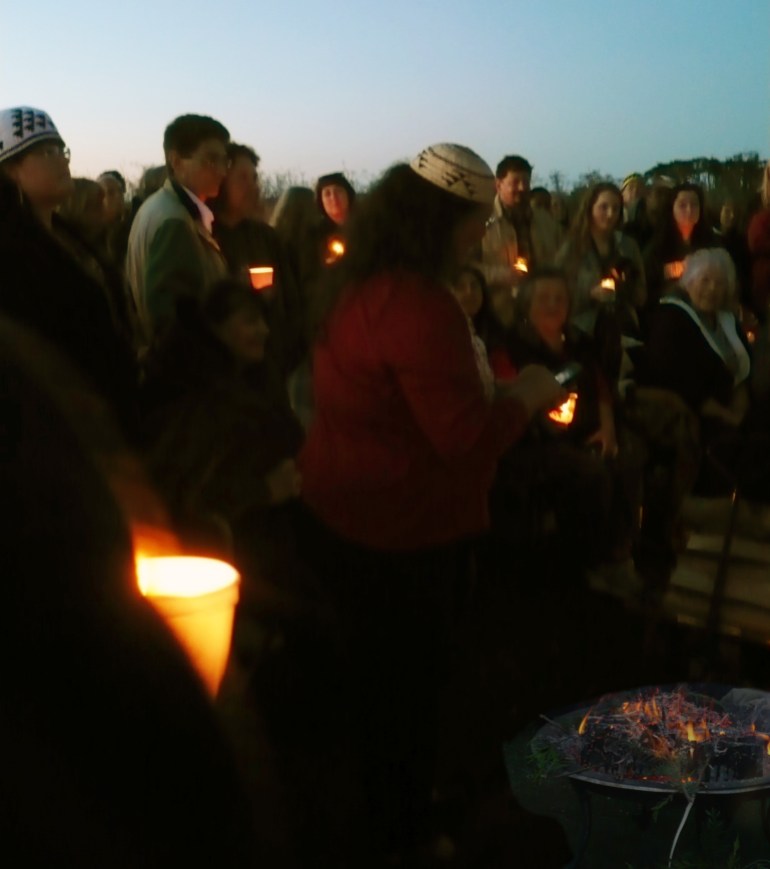
Completing an interrupted ceremony
William Frank IV never thought he would be part of a Wiyot world renewal ceremony. Not because of the massacre necessarily, but because — for many years — he did not know he was Wiyot, to begin with.
Frank had grown up with his maternal grandmother and grandfather in the quiet city of Petaluma, more than 322km (200 miles) south of Humboldt Bay. Most of his classmates in elementary school were either white or Latino. It did not occur to him that he was Indigenous — not until much later.
“When I was in Petaluma, I didn’t really know who my identity was. I was still trying to find myself,” Frank, 27, says. “I had no clue that I was even part of the tribe.”
But that changed at age 15 when Frank moved north to live with his mother, a Wiyot woman. When he arrived at the Table Bluff Reservation, residents greeted him with memories of his early childhood — memories Frank himself had no recollection of.
It was overwhelming, Frank says. “I would ask my mom, ‘Who are these people?’ She laughed and said, ‘This is your family. These are your cousins.’”
At his new school, he bonded with classmates over shared Indigenous heritage. At home, his relatives taught him to play traditional stick games. And during visits to his great-great-granduncle Albert James — the same uncle Seidner used to visit — he learned the history of the Wiyot people.
“I became very well aware of where we came from and what the island meant to us,” Frank says. “We sat down, had a cup of coffee, and I just asked questions.”
Every once in a while, someone would remind Frank that he was the spitting image of his father, a man of Hupa, Yurok and Pomo descent. “I didn’t grow up with my father in my life,” Frank explains. But the year Frank moved to Table Bluff was the year that changed too.
Frank had started practising Indigenous dances to perform at events and ceremonies. One was a brush dance to heal the sick. “When we sing our songs and we dance and we holler, we scare the bad medicine away. What I mean by bad medicine is sickness,” Frank explains.
His father performed brush dances. He “never missed a dance, never missed a ceremony”, Frank says.
So they started meeting at events. Frank discovered that his father was a short man: at 5 feet, 10 inches (178cm), Frank towered over him. And something about his father’s long dark hair reminded him of a bespectacled version of the warrior Geronimo.
“If I didn’t have culture in my life, I probably wouldn’t have known my dad,” Franks says. His father passed away last year.
But at the time, Frank would sit across the fire from his father and learn his stories and songs. Through ceremony, they “got close”. One day, his father even offered to teach Frank a river brush song that had been in the family for generations. He ended the lesson by saying, “Now this is your song. Sing it well, sing it proud and sing it loud.”
In 2014, Frank was surprised when Seidner invited him to be part of the world renewal ceremony. She and other Wiyot leaders were planning to complete the ceremony that the massacre had interrupted. Frank felt it was one of the biggest honours of his life.
To prepare, he collected firewood and fasted on acorn mush and small pieces of salmon jerky. He camped out on Tuluwat to ensure everything was set up. But when participants finally arrived on the island for the ceremony, the sky opened up — and rain started to fall.
And yet, somehow, the fire they built kept burning. Frank sensed that this was no ordinary downpour. “We all had the same feeling that, when it poured down and rained, it was the ancestors that were there on the island before us all. It was their tears of joy and tears of happiness, because we finished what they couldn’t.”
He remembers looking over at Seidner, one of the driving forces behind the ceremony’s return. She was doing her best to hold back tears.
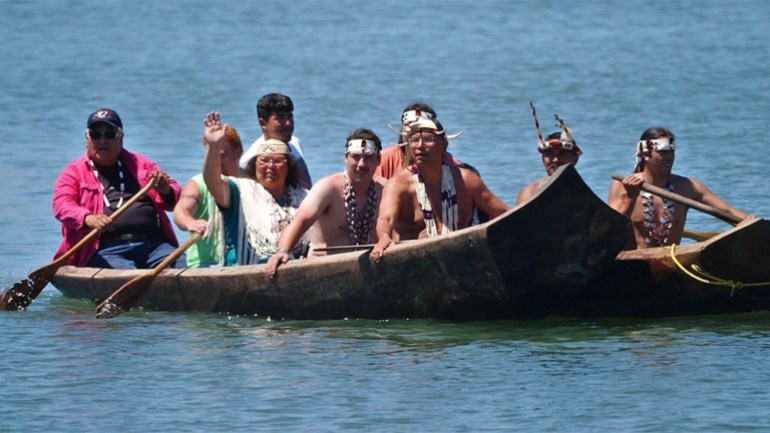
The historic return of Tuluwat Island
Seidner had not set foot on Tuluwat Island until she was in her 40s. She simply couldn’t. Without permission, it would have been trespassing. But now, the northernmost part of the island was in Wiyot hands, for the first time in more than 150 years.
Still, the vast majority of the island belonged to the city of Eureka, with a couple of small parcels held by private owners. It did not sit right with Seidner. She decided to approach the mayor’s office to ask for the land back.
“Hey, there’s no harm in asking,” Seidner thought. The first time she asked, though, the answer was basically “no way”. But the passing years brought new elections, and with them a new mayor in 2010: Frank Jager.
“I just called him up, and he came to the telephone,” Seidner says. She was tribal chair at the time, a position of leadership in the Wiyot community. “I introduced myself to him, and I said, ‘Mr Mayor, I would like for Eureka to give back our island.’”
Seidner remembers Jager seemed shocked at first by the request. He umm-ed and ah-ed over the telephone line. But still, they arranged to sit down together and talk.
At first, it was a bumpy process. According to Seidner, lawyers and officials speculated that returning the island could expose the city to lawsuits — or open the land to unwanted development.
But ultimately, in October 2019 — after years of negotiations — the Eureka City Council voted unanimously to return Tuluwat Island to the Wiyot people. “This is the right thing to do,” councilmember Kim Bergel said at the podium when the transfer was formally announced. “It’s always been the right thing to do.”
Applause broke out in the community centre where the announcement was made. Cutcha Risling Baldy, the department chair of Native American Studies at Cal Poly Humboldt, remembers it as a moment of pure joy. Onlookers turned to one another and hugged — Indigenous and settler alike.
“It felt like the world was getting set back into balance,” recalls Risling Baldy.
A member of the nearby Hoopa Valley tribe, Risling Baldy had grown up knowing about the Wiyot massacre. When she was a child, her mother, a historian, made sure to point out key landmarks as they drove through Eureka: up there, on that grassy bluff, stood Fort Humboldt, where Indigenous people were imprisoned. Down there, past the edge of the Samoa Bridge, was Tuluwat Island, where the massacre took place.
Risling Baldy cannot remember a time when she did not know about Seidner and her work in the community. Their families were friends. Risling Baldy attended the bake sales, auctions and gatherings Seidner held to raise money. And when Seidner helped lead the first coming-of-age ceremony in more than a century, Risling Baldy was there, bundled in coats and jackets to withstand the damp cold.
She still remembers the sun rising after a night of ceremony. The songs they sang started to mingle with the sounds of birds chirping and the world awakening. Witnessing ceremonies like that return left Risling Baldy feeling “unstoppable”.
Nowadays, as a professor, Risling Baldy sometimes hears Indigenous people spoken of in past tense — or solely in reference to what they lost. This makes her bristle.
“I don’t use the language that we lost culture, we lost language, we lost ceremony,” she says. “We didn’t lose any of those things. Those things were violently wrested away from us by colonisation.”
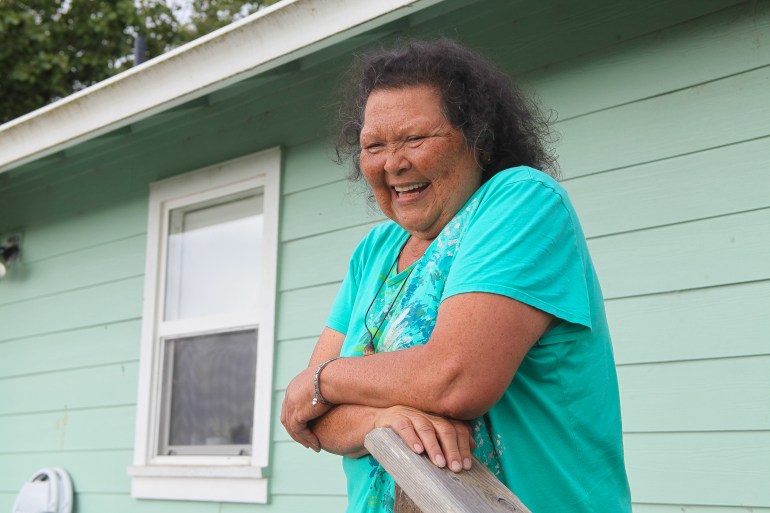
‘I have seen impossible things made possible’
But the story of Indigenous people in the US did not end with violence. For Risling Baldy, Seidner is living proof of that.
“When Cheryl first goes and says, ‘We’re going to get that island back. That’s what we’re going to do,’ people told her that that was impossible — that that would never happen,” Risling Baldy says.
“Then you fast forward to a few years ago and they’re returning it to the Wiyot peoples. So impossible things are happening in my lifetime. I have seen impossible things made possible.”
Beth Rose Middleton Manning — a professor of Native American Studies at the University of California, Davis — has also seen momentum build around Indigenous stewardship of the land over the last decade.
She points to recent government appointments as the result of years of advocacy and growing Indigenous political power. In 2021, Deb Haaland became the first Indigenous person to lead the US Department of the Interior. Charles F Sams III was sworn in that same year as the country’s first Indigenous National Park Service director. Even locally, in California, the state assembly welcomed its first Indigenous member with the election of James Ramos in 2018.
Just this March, California Governor Gavin Newsom proposed setting aside $100m to increase tribal access to ancestral land, including through land return. But Middleton Manning hastens to add, “There’s a long way to go.”
It was a heartening sign, Middleton Manning says, that the city of Eureka took a public stand in returning Tuluwat to the Wiyot people.
“Sometimes it seems like entities want to be quiet about the land transfers — like maybe they don’t want to be sued by someone who might oppose the land transfer, for example,” she says. “I appreciate that the city of Eureka was open about the process because that enables it to be a kind of beacon and example.”
But even with Tuluwat back in Wiyot hands, Seidner is still looking to what is missing, what is still needed to help her community. Atop the small deck overlooking her back yard, fluttering with goldfinches and ripe with strawberries, Seidner reflects on how her ancestors might react to all she has accomplished.
“Well, I would hope they would feel good about it,” she starts. “But they might also ask: What does it do for the people? How does that put food on the table? How does that pay for your bills?”
There is still work to be done, she believes, to erase the injustices of the past. And as she looks towards the horizon, where the churning sky disappears into a steely sea, she thinks of her parents and her grandparents, turning to their example as her guide forward.





Pingback: USDT
Pingback: how to join the illuminati
Pingback: Online medicatie kopen zonder recept bij het beste Benu apotheek alternatief in Amsterdam Rotterdam Utrecht Den Haag Eindhoven Groningen Tilburg Almere Breda Nijmegen Noord-Holland Zuid-Holland Noord-Brabant Limburg Zeeland Online medicatie kopen zonder r
Pingback: have a peek at this website